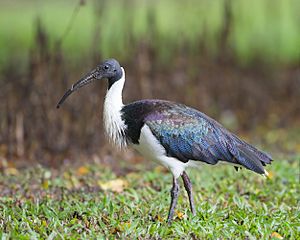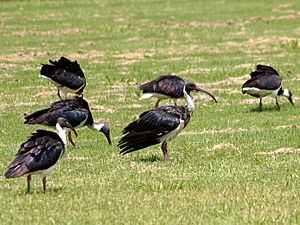Straw-necked ibis facts for kids
Quick facts for kids Straw-necked ibis |
|
|---|---|
 |
|
| Adult in Queensland | |
| Conservation status | |
| Scientific classification | |
| Genus: |
Threskiornis
|
| Species: |
spinicollis
|
The straw-necked ibis (its scientific name is Threskiornis spinicollis) is a cool bird from the ibis and spoonbill family. You can find these birds in Australia, New Guinea, and some parts of Indonesia. Grown-up straw-necked ibises have special feathers on their necks that look like straw. This is how they got their name!
Contents
What Does a Straw-necked Ibis Look Like?
Straw-necked ibises are big birds. They are about 59–76 cm (23–30 in) long. They have a black head with no feathers and a long, black beak that curves downwards.
Their feathers are very special and shiny. They can look dark brown in dim light. But in the sun, their wings shine with many colors like blue, purple, green, and bronze! Their back is shiny blue-black, and they have a dark collar. The top part of their neck is white, and their belly and under-tail are also white. Their legs are usually red near the top and dark grey closer to their feet.
Adult birds have those unique straw-colored feathers on their necks. Their wings can spread out about 100–120 cm (39.5–47 in) wide. They usually weigh around 1.1–1.5 kg (2.5–3.5 lb).
Male and female ibises look quite similar. However, males have longer beaks. Female ibises have a dark stripe across their upper chest. Young ibises have duller colors and shorter, straighter beaks. They do not have the straw-like feathers on their necks yet.
Where Do Straw-necked Ibises Live?
You can find straw-necked ibises all over Australia. They build their nests in most states and territories, except in the very dry inner parts of the country. They are most common along the east coast. Sometimes, they fly to New Zealand, Norfolk Island, and Lord Howe Island.
They are seen less often in New Guinea and Indonesia. You might also spot them sometimes in Tasmania and other islands near the Bass Strait.
These birds like to live near shallow freshwater wetlands. They also enjoy cultivated pastures, and the edges of swamps and lagoons. They can be found in wet or dry grasslands too. They usually stay away from very dry areas, saltwater places, and muddy coastal areas.
Straw-necked ibises move around a lot. They are always looking for good places to live. You might often see them standing on high branches of bare trees, looking like a silhouette against the sky.
How Do Straw-necked Ibises Behave?
Straw-necked ibises are partly migratory. This means some birds stay in one place, while others travel. They move around when water levels change. Some travel from southeastern and northern Australia. Others move between the coast and inland wetlands in central Australia. They also fly across the Torres Strait between Australia and southern New Guinea.
Birds that are not breeding arrive in western Australia and leave in autumn. Their arrival dates often match up with how much rain fell in the spring before. When they fly long distances, they usually fly in a line or in a "V" shape. They can fly very high in the sky.
They make sounds mostly when they are in their breeding colonies. Their calls sound like croaks, barks, and grunts. When they are flying, they might make a rough grunt every now and then.
They feed in groups, sometimes with up to 200 birds! They use their long beaks to search for food in soil, mud, cracks, plants, or shallow water.
What Do Straw-necked Ibises Eat?
Straw-necked ibises mainly eat small animals without backbones, called invertebrates. However, their diet can change.
In shallow water, they eat water insects, molluscs (like snails), frogs, freshwater crayfish, and fish. On land, they love to eat grasshoppers, crickets, and locusts. This is why they are often called the "Farmer's Friend"! They help farmers by eating pests that would otherwise eat farm crops. They also eat small lizards, skinks, and other tiny reptiles.
Sometimes, they might eat toads (like the cane toad), snakes, and rodents. They might even eat human food waste sometimes. But they are not as good at finding all kinds of food as the Australian white ibis. They rarely scavenge for food.
Reproduction and Life Cycle
The breeding season for straw-necked ibises changes a lot. It mostly depends on how much water is available. In southwestern Australia, they usually breed from August to December. Sometimes, they breed in the north, but not very often. In central and northern areas, breeding has been seen in all months of the year. This usually happens in the year after heavy rain.
They build a large, rough, cup-shaped nest. They use sticks and trampled plants. They build these nests among reeds, paperbark trees, bulrushes, or other trees that are over water. They breed in colonies, which are large groups. They often share these colonies with the Australian white ibis. They use the same nests year after year.
A female ibis usually lays 2 to 5 eggs. Both parents take turns sitting on the eggs for about 24 to 25 days until they hatch. Both parents also feed and care for the young birds. The young birds leave the nest about 35 days after hatching. The parents feed them by bringing up food from their own stomachs. This feeding continues for up to two weeks after the young birds leave the nest.
See also
 In Spanish: Ibis australiano para niños
In Spanish: Ibis australiano para niños




